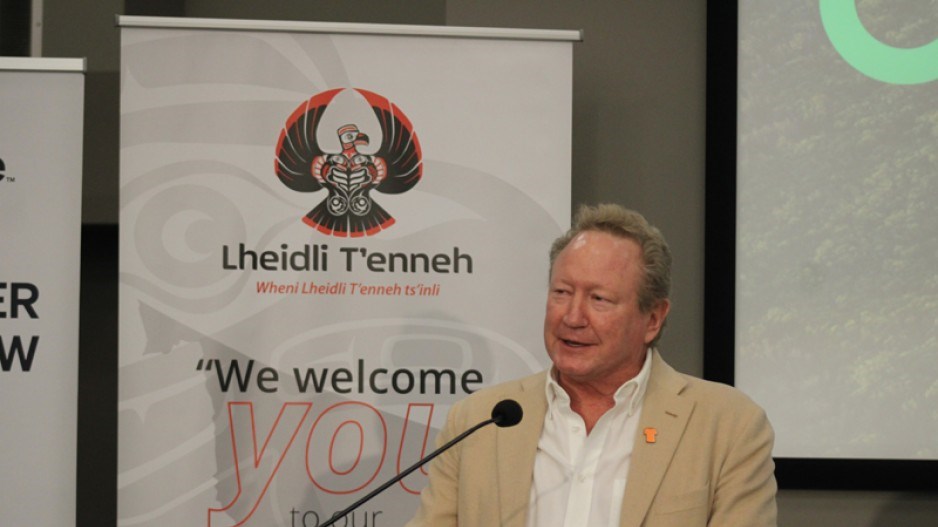A $2 billion green hydrogen project proposed for Prince George is among those that will be pushed back, as the proponent, Fortescue Minerals Group, scales back on its green hydrogen ambitions and focuses on those with the best economics.
Last year, Fortescue Future Industries, a subsidiary of Fortescue Minerals Group, announced plans to build a $2 billion green hydrogen and ammonia plant in Prince George.
Fortescue has also signed memorandums of understanding with Newfoundland First Nations, with plans for hydrogen electrolysis and green ammonia production plant, liquid ammonia marine export terminal, and wind power generation facility.
The proposed Coyote Project in Prince George would have an annual production capacity if 140,000 tonnes of hydrogen and 700,000 tonnes of ammonia per year.
But the amount of power the project would need from BC Hydro led some observers to question if the project could ever be built.
The Coyote project would require 1,000 megawatts of power, which represents 90 per cent of the generating capacity of the $16 billion Site C dam.
Barry Penner, chairman of the Energy Futures Institute, noted that 1,100 MW is Site C's rated maximum generating capacity. In reality, its average generating capacity would be more in the 582 MW range.
“It was never clear to me at the Energy Futures Institute where that 1,000 megawatts of electricity was going to come from,” Penner told BIV News.
“While it’s true the Site C dam is nearing completion and is not far, in the transmission sense, from where this project was going to be located, we know that the output for the Site C dam is more than spoken for already.”
Last week, the Australian Broadcast Corporation Fortescue Minerals’ plans to scale back its goal to produce 15 million tonnes of green hydrogen by 2030, and cut 700 jobs associated with Fortescue Future Industries.
Richard McCandless, a former ÎÚÑ»´«Ã½ bureaucrat who now writes about public policy, recently wondered out loud if that means the Coyote project is now dead in the water.
“It remains to be seen if the retrenchment by the FMG will be reflected in the decision to abandon work on the massive Prince George green hydrogen project,” McCandless wrote.
Asked if the Coyote project is among those projects that may get pushed back in terms of priority, Fortescue confirmed by email that it is. The company said it will focus on green hydrogen projects in countries where the economics are better.
“Fortescue is steadfast in its commitment to green hydrogen,” the company wrote in an email to BIV News. “However, our financial discipline always comes first. We will never do projects that are not economically viable.”
Fortescue said it will be focusing initially on four green hydrogen projects in Australia, the U.S., Norway and Brazil.
“We also have large projects in Oman, Morocco, Egypt and Jordan which will follow our initial projects,” the company wrote.
“Fortescue will continue to maintain a large portfolio of projects for the future, which show potential for decarbonisation and economic growth, including in ÎÚÑ»´«Ã½. These projects will progress if conditions improve to achieve economic viability, including lower power costs and increasing global demand for hydrogen.
“By focusing on projects in jurisdictions where the economics stack up now, we are demonstrating our rock-solid commitment to green hydrogen as a part of the world’s future zero emissions energy mix.”
The Coyote project is currently in the early stages of a BC Environmental Assessment (EAO) review. So far, Fortescue has not asked that the project be withdrawn or paused.
Penner, who is at the Pacific Northwest Economic Region Conference in Whistler this week, noted that Premier David Eby was apparently unaware of Fortescue’s plans to scale back its green hydrogen ambitions when he spoke in favour of the Coyote project on Monday.
“Premier Eby addressed the crowd yesterday, and he talked about the project in Prince George in favourable terms,” Penner said. “And quite a few people in the crowd looked at each other, wondering if he had heard that project was already essentially on hold.”
Penner said he just doesn't think ÎÚÑ»´«Ã½ has enough clean electricity for a project on the scale of the Coyote project.
“Until someone can answer the question, ‘where is the electricity going to come from?’ it’s just hard to see a path forward,” Penner said.
McCandless also does not think the Coyote project has much chance of getting built.
"There's no question that the project was far too ambitious for what ÎÚÑ»´«Ã½ could tolerate for its electricity usage," he said.



